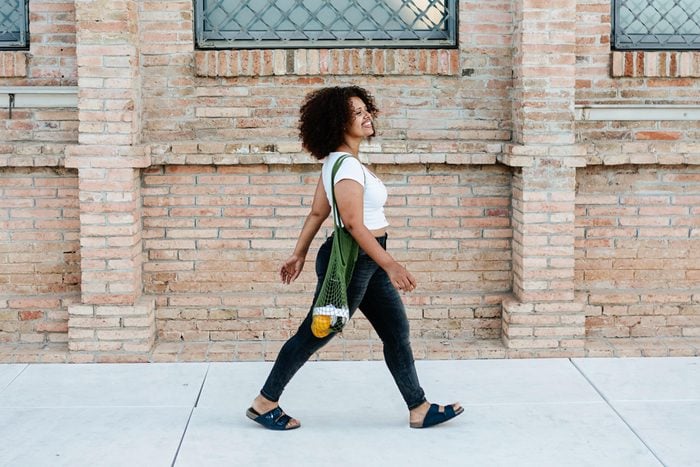Here’s How Long You Need to Walk to Lower Your Blood Sugar, New Research Finds
Updated: Aug. 09, 2022

Sports medicine researchers suggest a short stroll can have a big impact on your blood sugar health.
If you’ve ever noticed a pattern of eaten something relatively heavy and high in carbohydrates…and then, noticed that your heart was pounding…then it’s very possible you’ve experienced the effects of high blood sugar, wherein the sugar level in your body actually thickens your blood and forces your heart to work harder to pump blood throughout your body. Keeping a balanced blood sugar level is important for everyone, even if you’re not diabetic—as approximately 40 million Americans are, according to data from the Centers for Disease Control and Prevention and the American Diabetes Association.
Fortunately, for many of us, the fix can be simple. According to a 2022 review in the peer-reviewed journal, Sports Medicine, bringing down your blood sugar could be a walk in the park. (Even a short one!)
9 Surprising Foods That Can Wreak Havoc on Your Blood Sugar
The effect of walking on blood sugar
A group of researchers at Ireland’s University of Limerick and Manchester Metropolitan University in England performed a meta-analysis of seven past studies that had compared the effects of sitting, standing, and light-intensity walking on blood pressure, insulin levels, and post-meal blood glucose (blood sugar), all which the researchers reported are considered to be “cardiometabolic health markers” that can be keys to indicating an individual’s risk factor for chronic illnesses like heart disease and diabetes. The past studies had included mixed-gender participants that were over 18 years old.
From their analysis, the researchers of the current study found that for people who were overweight or obese, simply standing “significantly” reduced blood sugar levels when compared to sitting.
However, the researchers reported, “Light-intensity walking was found to be a superior intervention compared to standing and prolonged sitting.”
The 3 Best Flip-Flops for Walking, according to Podiatrists
So what’s considered light-intensity walking? The past studies showed effectiveness for a two-minute walking break every 20 minutes and a five-minute walking break every 30 minutes. The walking speeds that researchers found to have “good” effect on blood sugar were between 1.5 miles per hour and two miles per hour.
The best part? Those participants had walked on a treadmill or a marked track. Imagine what just getting out in the fresh air could do for your body!
What’s a healthy blood sugar level?
The Mayo Clinic suggests that a blood sugar level of less than 140 milligrams per deciliter is “normal.” However, this can vary depending on certain health factors and when you’ve eaten your last meal. To determine the healthiest blood sugar level for you, it’s best to speak with your licensed healthcare provider.
Get The Healthy @Reader’s Digest newsletter for wellness inspiration delivered daily, and follow The Healthy on Facebook, Instagram, and Twitter. Keep reading.
